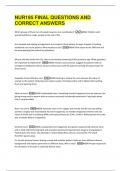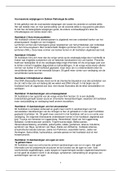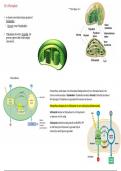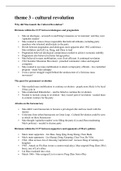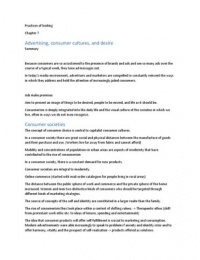FAR
Lecture 1 Chapter 1
- Managerial Accounting is the process of identifying, measuring and communicating economic information to
permit informed judgement and decisions by users of the information.
- Financial accounting is the process of the preperation of financial reports on the enterprise for use by both
internal (board of directors/management) and external parties (capital providers)
o Financial reports; output with relevant and reliable information that is useful for making economic
decisions by capital providers and other stakeholders.
The general purpose of financial reporting is to provide financial information about the reporting entity that is useful
to existing and potential investors, lenders and other creditors in making decisions about providing resources to the
entity. It is thus the communication of information for economic decision making;
- Resource allocation decisions; providing resources to and by an entity
o Buying, selling (or holding) shares and other equity instruments
o Providing or settling loans and other forms of credit
o Profit allocation & dividend distribution decisions
- Accountability; assessing management stewardship
o Monitoring managers’ activity, so they have to account for choices made
o Discharge management from responsibility
- Protection of capital providers
o If a company makes a loss, it is economically & legally acceptable to pay dividends. You can subtract
the net loss from the retained earnings and the amount that remains can be used to pay dividends.
Financial reporting has changed (developed) a lot;
Separation of Ownership & Control - Separation of Finance & Management - Public and private companies -
Subsidiaries in more countries, which requires more need for financial information - Growing importance of global
markets - More complex governance & control structures, with international capital provides and board of directors -
More information available, including misleading information & information overload, so more need for relevant &
reliable information - More room for agency problem, so more need for comparable and relevant information
!! Thus overall, there is more need for high quality financial reports.
Agency theory;
- There is a Principal-Agent goal conflict among participants
o In Financial accounting, the principal is the capital provider and the agent is the top management
o In Mangement accounting, the prncipal is top management and the agent is the employee
- There is bounded rationality
- There is opportunistic, self-interested behaviour with different risk attitudes and preferences
- There is asymmetric information, which can be made less by using financial reports with accounting
standards and an external auditor. An External auditors inspect clients' accounting records and expresses an
opinion as to whether financial statements are presented fairly.
o IFRS: International Financial Reporting Standards
o IASB: International Accounting Standards Board (from 2002)
o IASC: International Accounting Standards Committee (1973-2001)
When a new standard is issued by the IASB, the EU needs to endorse it before it comes into
force, following a specific endorsement process under the responsibility of the European
Commission.
EU-listed companies and financial institutions have to prepare their consolidated financial
statements under IFRS 'adopted’ for application within the EU.
Legal entities
Micro Small Medium-sized Large
Preperations
- balance sheet with notes very limited limited complete complete
- income statement with notes very limited limited limited complete
Disclosure
- balance sheet with notes very limited limited complete complete
- income statement with notes not not limited complete
, External audit Exemption Exemption No exemption No exemption
Lecture 2 Chapter 2 & 3
Basic elements of a financial statement
- Assets; a present economic resource with the potential to produce economic benefit, that is controlled by
the entity as a result of past events.
o Inventory, machinery, cash, etc.
- Liability; a present obligation of the entity to transer an economic resource as a result of past events.
o Loan, accounts payable
- Equity; the residual interest in th assets of the entity after deducting all its liabilities
- Income; increases in assets or decreases in liabilities, that result in increases in equity other than those
relating to contributions from holders of equity claims.
- Expenses; decrease in assets, or
increases in liabilities, that result
in decreases in equity other than
those relating to distributions to
holders of equity claims.
Fundamental quality of accounting information
- Relevance; to be relevant, accounting information must be capable of making a difference in a decision.
o Predictive value; financial information has this value as an input to predictive processes used by
investors to form their own expectations about the future.
o Confirmatory value; financial information has this value if it helps users confirm or correct prior
expectations.
o Materiality; if omitting or misstating information could influence dcision that users make on the
basis of the reported financial information.
- Faithful representation; the numbers and descriptions match what really existed or happened
o Completeness; all the information that is necessary for faithful representation is provided
o Neutrality; a company cannot select information to favor one set of interested parties over another
o Free from error; information is a more accurate (faithful) representation of a financial item
Enhancing qualitative characteristics are complementary to the fundamental qualities of accounting information
- Comparability; information that is measured and reported in a similar manner for different companies, so
that it can be used to compare.
- Verifiability; different knowledgeable and independent observes could reach consensus (are the same)
- Timeliness; having information available to decisionmakers before it loses its capacity to influence decisions.
- Understandability; the quality of information that lets reasonably informed users see its significance.
Exercise;
Statement characteristics
Quality of information that confirms users’ earlier expectations. Confirmatory value
Ignores the economic consequences of a standard or rule. Neutrality
Qualitative characteristic being displayed when companies in the same Comparability
industry are using the same accounting principles.
Imperative for providing comparisons of a company from period to period. Comparability
Requires a high degree of consensus among individuals on a given Verifiability
measurement.
Predicted value is an ingredient of this fundamental quality of information. Relevance
Four qualitative characteristics that enhance both relevance, and faithful Timeliness, verifiability,
representation. understandability, comparability
Neutrality is a key ingredient of this fundamental quality of accounting Faithful representation
, information.
Two fundamental qualities that make accounting information useful for Relevance, faithful representation
decision-making purposes.
Issuance of interim reports is an example of what enhancing ingredient? timeliness
How to reach the general goal of accounting? through recognition, measurement and disclosure concepts.
Recognition, measurement and disclosure concepts of accounting;
- Assumptions;
o Economic entity; the company keeps its activity separate from its owners & any other business unit.
o Going concern; company lasts long enough to fulfill objectives & commitments (foreseeable future)
o Monetary unit; money as the common denominator
o Periodicity; company can divide its economic activities into time periods
o Accural basis of accounting; transactions are recorded in the periods in which the events occur.
Identify which basis assumption of accounting is best described in each item below;
- The economic activities of FedEx are divided into 12-month periods for the purpose of issuing annual reports periodicity
- Total SA does not adjust amounts in its financial statement for the effects of inflation monetary unit
- Barclays reports current and non-current classification in its statement of financial position going concern
- The economic activities of Apple and its subsidiaries are merged for accounting and reporting purposes economic entity
- Principles;
o Measurement principle
Historical cost is a faithful representation of the amount paid for a given item
Fair value (IFRS) is the price that would be received to sell, or paid, to transfer a liability in
an orderly transaction between market participants at the measurement date.
o Revenue recognition principle
When a company agrees to perform a service or sell a product to a customer, it has a
performance obligation. The revenue recognition principle requires that companies
recognize revenue in the accounting period in which the performance obligation is satisfied.
o Expense recognition principle
Recognizing the product costs in the period of revenue, since there is a direct relationship
between cost and revenue (matching).
Expense the period costs as they occur, because there is no relationship between period
cost and revenue.
o Full disclosure principle
Providing information that is of sufficient importance to influence the judgement and
decisions of an informed user. This information is provided through; financial statements,
notes to the financial statements or through supplementary information.
- Cost constraints;
o companies must weight the costs of providing the information against the benefits that can be
derived from using it.
Rule- making bodies
and governmental
agencies use cost-
benefit analysis before
making final their information requirements. The benefits must exceed the costs.
Accounting equation;
- The basic equation; Assets = liabilities + equity
- The expanded equation;
Financial statements
- Income statement
o Revenue – expenses = net income (loss)
- Retained earnings statement
Lecture 1 Chapter 1
- Managerial Accounting is the process of identifying, measuring and communicating economic information to
permit informed judgement and decisions by users of the information.
- Financial accounting is the process of the preperation of financial reports on the enterprise for use by both
internal (board of directors/management) and external parties (capital providers)
o Financial reports; output with relevant and reliable information that is useful for making economic
decisions by capital providers and other stakeholders.
The general purpose of financial reporting is to provide financial information about the reporting entity that is useful
to existing and potential investors, lenders and other creditors in making decisions about providing resources to the
entity. It is thus the communication of information for economic decision making;
- Resource allocation decisions; providing resources to and by an entity
o Buying, selling (or holding) shares and other equity instruments
o Providing or settling loans and other forms of credit
o Profit allocation & dividend distribution decisions
- Accountability; assessing management stewardship
o Monitoring managers’ activity, so they have to account for choices made
o Discharge management from responsibility
- Protection of capital providers
o If a company makes a loss, it is economically & legally acceptable to pay dividends. You can subtract
the net loss from the retained earnings and the amount that remains can be used to pay dividends.
Financial reporting has changed (developed) a lot;
Separation of Ownership & Control - Separation of Finance & Management - Public and private companies -
Subsidiaries in more countries, which requires more need for financial information - Growing importance of global
markets - More complex governance & control structures, with international capital provides and board of directors -
More information available, including misleading information & information overload, so more need for relevant &
reliable information - More room for agency problem, so more need for comparable and relevant information
!! Thus overall, there is more need for high quality financial reports.
Agency theory;
- There is a Principal-Agent goal conflict among participants
o In Financial accounting, the principal is the capital provider and the agent is the top management
o In Mangement accounting, the prncipal is top management and the agent is the employee
- There is bounded rationality
- There is opportunistic, self-interested behaviour with different risk attitudes and preferences
- There is asymmetric information, which can be made less by using financial reports with accounting
standards and an external auditor. An External auditors inspect clients' accounting records and expresses an
opinion as to whether financial statements are presented fairly.
o IFRS: International Financial Reporting Standards
o IASB: International Accounting Standards Board (from 2002)
o IASC: International Accounting Standards Committee (1973-2001)
When a new standard is issued by the IASB, the EU needs to endorse it before it comes into
force, following a specific endorsement process under the responsibility of the European
Commission.
EU-listed companies and financial institutions have to prepare their consolidated financial
statements under IFRS 'adopted’ for application within the EU.
Legal entities
Micro Small Medium-sized Large
Preperations
- balance sheet with notes very limited limited complete complete
- income statement with notes very limited limited limited complete
Disclosure
- balance sheet with notes very limited limited complete complete
- income statement with notes not not limited complete
, External audit Exemption Exemption No exemption No exemption
Lecture 2 Chapter 2 & 3
Basic elements of a financial statement
- Assets; a present economic resource with the potential to produce economic benefit, that is controlled by
the entity as a result of past events.
o Inventory, machinery, cash, etc.
- Liability; a present obligation of the entity to transer an economic resource as a result of past events.
o Loan, accounts payable
- Equity; the residual interest in th assets of the entity after deducting all its liabilities
- Income; increases in assets or decreases in liabilities, that result in increases in equity other than those
relating to contributions from holders of equity claims.
- Expenses; decrease in assets, or
increases in liabilities, that result
in decreases in equity other than
those relating to distributions to
holders of equity claims.
Fundamental quality of accounting information
- Relevance; to be relevant, accounting information must be capable of making a difference in a decision.
o Predictive value; financial information has this value as an input to predictive processes used by
investors to form their own expectations about the future.
o Confirmatory value; financial information has this value if it helps users confirm or correct prior
expectations.
o Materiality; if omitting or misstating information could influence dcision that users make on the
basis of the reported financial information.
- Faithful representation; the numbers and descriptions match what really existed or happened
o Completeness; all the information that is necessary for faithful representation is provided
o Neutrality; a company cannot select information to favor one set of interested parties over another
o Free from error; information is a more accurate (faithful) representation of a financial item
Enhancing qualitative characteristics are complementary to the fundamental qualities of accounting information
- Comparability; information that is measured and reported in a similar manner for different companies, so
that it can be used to compare.
- Verifiability; different knowledgeable and independent observes could reach consensus (are the same)
- Timeliness; having information available to decisionmakers before it loses its capacity to influence decisions.
- Understandability; the quality of information that lets reasonably informed users see its significance.
Exercise;
Statement characteristics
Quality of information that confirms users’ earlier expectations. Confirmatory value
Ignores the economic consequences of a standard or rule. Neutrality
Qualitative characteristic being displayed when companies in the same Comparability
industry are using the same accounting principles.
Imperative for providing comparisons of a company from period to period. Comparability
Requires a high degree of consensus among individuals on a given Verifiability
measurement.
Predicted value is an ingredient of this fundamental quality of information. Relevance
Four qualitative characteristics that enhance both relevance, and faithful Timeliness, verifiability,
representation. understandability, comparability
Neutrality is a key ingredient of this fundamental quality of accounting Faithful representation
, information.
Two fundamental qualities that make accounting information useful for Relevance, faithful representation
decision-making purposes.
Issuance of interim reports is an example of what enhancing ingredient? timeliness
How to reach the general goal of accounting? through recognition, measurement and disclosure concepts.
Recognition, measurement and disclosure concepts of accounting;
- Assumptions;
o Economic entity; the company keeps its activity separate from its owners & any other business unit.
o Going concern; company lasts long enough to fulfill objectives & commitments (foreseeable future)
o Monetary unit; money as the common denominator
o Periodicity; company can divide its economic activities into time periods
o Accural basis of accounting; transactions are recorded in the periods in which the events occur.
Identify which basis assumption of accounting is best described in each item below;
- The economic activities of FedEx are divided into 12-month periods for the purpose of issuing annual reports periodicity
- Total SA does not adjust amounts in its financial statement for the effects of inflation monetary unit
- Barclays reports current and non-current classification in its statement of financial position going concern
- The economic activities of Apple and its subsidiaries are merged for accounting and reporting purposes economic entity
- Principles;
o Measurement principle
Historical cost is a faithful representation of the amount paid for a given item
Fair value (IFRS) is the price that would be received to sell, or paid, to transfer a liability in
an orderly transaction between market participants at the measurement date.
o Revenue recognition principle
When a company agrees to perform a service or sell a product to a customer, it has a
performance obligation. The revenue recognition principle requires that companies
recognize revenue in the accounting period in which the performance obligation is satisfied.
o Expense recognition principle
Recognizing the product costs in the period of revenue, since there is a direct relationship
between cost and revenue (matching).
Expense the period costs as they occur, because there is no relationship between period
cost and revenue.
o Full disclosure principle
Providing information that is of sufficient importance to influence the judgement and
decisions of an informed user. This information is provided through; financial statements,
notes to the financial statements or through supplementary information.
- Cost constraints;
o companies must weight the costs of providing the information against the benefits that can be
derived from using it.
Rule- making bodies
and governmental
agencies use cost-
benefit analysis before
making final their information requirements. The benefits must exceed the costs.
Accounting equation;
- The basic equation; Assets = liabilities + equity
- The expanded equation;
Financial statements
- Income statement
o Revenue – expenses = net income (loss)
- Retained earnings statement

